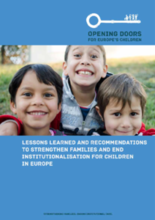Executive Summary
It all started, in 2013, with a common vision: to end institutional care for children in Europe. Decades of research show that institutional care simply cannot provide the one-to-one care, love, and attention a child needs to develop. The European Union plays a key role in transforming child protection systems, by providing the additional investment needed to accelerate reform, leading the transfer of knowledge and experience among Member States, and keeping the transition from institutional to family- and community-based care high on the political agenda.
To maximise the potential of the European Union and realise the vision where no child grows up in institutional care, civil society organisations across EU Member States, pre-accession countries and neighbourhood countries came together under a pan-European campaign: Opening Doors for Europe’s Children. The campaign aimed to support national efforts to develop comprehensive, integrated child protection systems that strengthen families and ensure quality family- and community-based care for children, by leveraging EU funding and policy, and building capacity in civil society. More than a sum of individual efforts at national level, the campaign presented a united position of relevant civil society organisations towards key decision-makers.
Based on the information gathered throughout the course of the campaign and through the Opening Doors for Europe’s Children National Coordinators, this final report first reflects on the rationale for the campaign and how it operated (part 1). Part two discusses the progress towards child protection system reform across campaign countries as well as the developments at the EU level, while highlighting some key contributions of Opening Doors throughout the years. The report does not attribute all the signs of change to the campaign, but rather provides an overview of the contributions made and progress achieved. Finally, drawing on the lessons learnt from the campaign, the report ends by presenting some final recommendations to the European Union (part 3).

